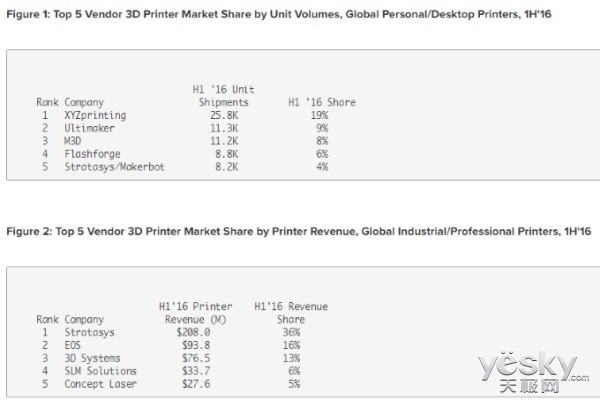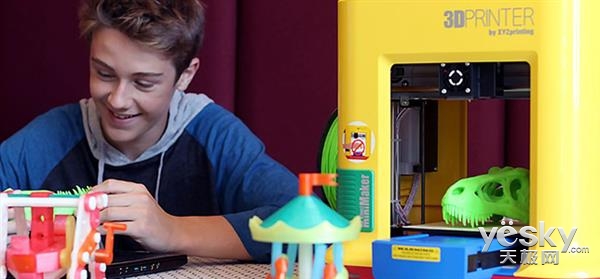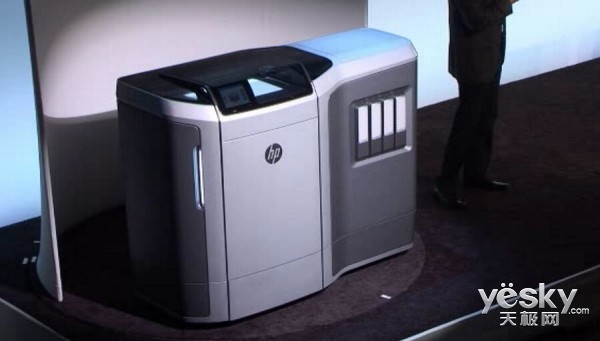A few days ago, the internationally renowned 3D printing professional website 3ders.org disclosed CONTEXT's report on “3D printing equipment sales in the first half of 2016â€. The report pointed out that shipments of industrial-grade 3D printing equipment did not perform well in the first half of the year, down 15 percentage points year-on-year. On the contrary, shipments of desktop-grade 3D printing equipment increased by 14 percentage points. At the same time, the report also pointed out that desktop-level 3D printing equipment is the main force in the growth of 3D printing equipment shipments in the first half of the year. Compared with last year, shipments of 3D printing equipment increased by 14 percentage points in the first half of this year.

Top is the desktop device ranking; below is the industrial device
Desktop-level Sanwei International Leading
In addition to pointing to sales of desktop-level devices compared to industrial-grade devices, the report also ranks desktop-level device sales. Among them, Taiwan's XYZ Printing showcased the first place in the desktop-level sales list, Ultimaker, M3D, Flashforge, and MakerBot (Stratasys) were second, third, fourth, and fifth respectively. According to the data, Sanwei International occupied 19% of the sales in the first half of 2016.
This report can be summarized as follows: First, industrial-grade equipment sales are sluggish, and shipments are much lower than desktop-level equipment. Second, desktop-class devices are still popular in the consumer-grade market. Although sales of desktop-class devices are still the mainstay, it is undoubted that 3D Systems has stopped production of desktop-class devices before moving to industrial-grade devices. Therefore, when judging whether a market is dynamic, it cannot be judged by one shipment alone, but also the capital direction, sales and the attitude of the giants to consumer equipment.

Sanwei International's sales of desktop equipment is leading Yaoyao
At present, the state manufactures 2025 to invest a lot of energy in additive manufacturing, including personnel training, technological innovation, market development and other aspects. However, consumer-oriented 3D printing devices cannot fly into civilian homes as expected. In other words, the profit model of consumer-grade 3D printing devices has yet to be explored. Whether it is O2O, community or strong promotion in the home market, as long as it is accepted and recognized. This road is still very long...·····
I need to be immersed after the bubble: Who is the research agency cheating?
The research organization CONTEXT pointed out that although the 3D printing market was dull in the first half of 2016, it still achieved a 14% increase in shipments. Compared to the CONTEXT survey data, Gartner's research seems to be more optimistic. The research team previously released a forecast that shipments of 3D printers in 2016 will increase by 108%. However, in the first half of the year, only 14% growth was achieved. If it can achieve 108% growth at the end of the year, it seems that the task of the 3D printing industry in the second half of the year is still very heavy.
Regarding the true and false proposition "2016 3D printer shipments will increase by 108%", Xiaobian also wants to discuss. From the first half of the year, shipments of consumer-grade 3D printing equipment increased by 14%, while shipments of industrial-grade 3D printing equipment fell by 15%. That is to say, in terms of shipments, the performance of industrial grade equipment does not have to be consumer grade. If the proposition of "2016 3D printer shipments will increase by 108%" is true, then the task of placing consumer-grade 3D printing devices is still quite heavy.
The small series is roughly calculated. If the growth rate is 14%, then the shipments in 2016 will only increase by 32% compared with last year. However, the research data of the research institute is by no means only calculated. However, in the unclear situation of the 3D printing industry, the research organization's data still has to help people to see the industry more clearly.
Shipment is not good at consumer development
First share a story about buying food: Mr. Wang went to the street to buy food, you need to buy 20 pounds of tomatoes (selling price: 2 yuan / kg). Mr. Wang thought carefully about giving him some losses at the original price, but he would not buy a 20-pound seller. So I found a compromise, that is, buy more and cut the price, so I bought 40 pounds at the price of 1 yuan / kg. From this story, we can see that Mr. Wang spends the same amount of money, but buys more dishes at the same amount of money. If you look at 40 pounds as a shipment, then it will increase by 100%, and the turnover will be a loss.

HP 3D printer
In the same way, in the development of the 3D printing industry, we can't just look at the shipments, but also the sales. According to the CONTEXT survey, sales of consumer-grade 3D printing equipment have increased, but sales are far lower than industrial-grade equipment. It can be seen from this that consumer-grade equipment will not be able to increase sales in a way that is measurable. In contrast, industrial grade equipment does not need to rely on volume to increase sales. In the consumer sector, due to the application of open source software, manufacturers are often easy to enter this threshold, but the days of blue light with Buddha are difficult to go on.
Then look at the sales of industrial grade 3D printing equipment and consumer-grade 3D printing equipment. According to the survey, industrial-grade 3D printers accounted for 78% of the total market sales. Among the 3D printing industry, the sales volume of the entire 3D printing industry increased by 3% in the first half of 2016. In the industry giants, the focus of attention has gradually shifted from Stratasys, 3D Systems and metal 3D printer manufacturers.
Editor's comment: In the first half of 2016, although the shipment of consumer-grade equipment increased, sales have become a paradox. On the contrary, although industrial-grade equipment has decreased in shipments, sales have continued to increase. So, to some extent, predicting data alone does not inspire the entire 3D printing industry. It can be predicted that in the future, manufacturers of industrial-grade 3D printer hardware devices will gradually turn to software and related services, because the hardware will be saturated sooner or later.
(Editor)
Sweet Orange Oil,Avocado Oil,Rose Hip Oil,Berries Essential Oil
Ji'An ZhongXiang Natural Plants Co.,Ltd. , https://www.zxnaturaloils.com